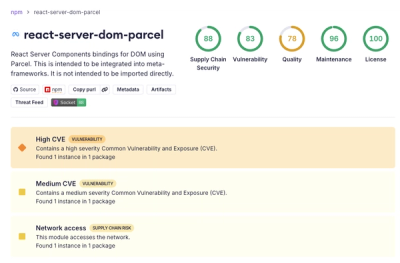
Security News
Deno 2.6 + Socket: Supply Chain Defense In Your CLI
Deno 2.6 introduces deno audit with a new --socket flag that plugs directly into Socket to bring supply chain security checks into the Deno CLI.
This light weight node js framework for developing web application with inbuilt jwt and user groups and roles



This is http frame work for developing rest api (back end) and also frontend. Rest api backend responces are served by JSON. This is a light weight frame work, unopinated supports the middleware for adding functionlites
recomended architure is
dir: app
dir:backend
files/dir:routes //routes of backend
dir:model database connection and bussiness logic
file:conn.js // database connection etc
dir:frontend
dir:HTML
file:index.html
dir:httmlerror
404.html
dir:assets(public folder)
dir:scripts
file:style.css
dir:styles
file:script.js
dir:img
file:img.jpg
file/dir:routes//for front end
index.js
package.json
package-lock.json
node_nodules
for backend routes advise is /backend/** or /api/** so that frontend routes do not conflict
// require jet-http
var app = require("jwt-http");
app.setPort(8002); //this sets the port number and also listens the server at specified port
place private key and certificate or public in the project folder
var options = {
key : fs.readFileSync(path.join(__dirname, "/key.pem")),
cert : fs.readFileSync(path.join(__dirname, "/cert.pem"))
}
options ={
key : keyPath,
cert : certPath
}
app.setHttpsServer(options, 8000);//8000 is port number
// routing
app.getMethod("/umesh", true,function(req, res){
app.httpMsgs.sendJSON(req, res, JSON.stringify(({
name : "Umesh Bilagi",
age : 47,
sex : "male"
}));
});
app.getMethod("/ramya" , true, function(req, res){
app.httpMsgs.sendJSON(req, res, JSON.stringify({
name : "Ramya Bilagi",
age : 35,
sex : "female"
}));
});
app.postMethod("/mypost", true,function(req, res){
var data= querystring.parse(req.body);//reqBody is data received
// now use posted data as per need
// after processing, if data need to send back to client
var processed_data = JSON.stringify(data)
app.httpMsgs.sendJSON(req, res, processed_data);
});
app.putMethod("/put", true, function(req, res){
var data = querystring.parse(req.body);
console.log(data);
app.httpMsgs.sendJSON(req, res, {
done : "done"
});
})
app.deleteMethod ("/delete/:id", true, function(req, res){
var id = req.params.id
app.httpMsgs.sendJSON(req, res, {
deleted_id : id
});
});
//first passing seo and human friendly parmeters "/employ/:id"
//above type routes can used where id is parmeter
//req.params contains conatains key value pairs of params and it values;
app.getMethod("/employ/:id", false, function(req, res){
app.httpMsgs.sendJSON(req, res, {"params" : req.params});
});
// querystring of url
//app.queryExpression() this method extract the query string i.e ?name=Umesh&age=34&sex=45
//app.getParsedQuery() this converts the query querystring in json
var emp = function(req, res){
app.httpMsgs.sendJSON(req, res, app.getParsedQuery());
}
app.getMethod("/emp" + app.queryExpression(), true, emp);
app.use(function(req, res, next){
//do the process of middle ware here
req.property_generic = "generic"
next(req, res, next);
});
//write middle ware as function
var curmiddleware = funtion(req, res, next){
req.property_specific = "specific"
next(req, res, next);
}
//route using middle ware
//second option in this set false so general middle ware is not used but specific middleware can be used
app.getMethod("/umesh", false, curmiddleware, function(req, res, next){
//code to send sendjson
app.httpMsgs.sendJSON(req, res, {
name : "Umesh Bilagi",
age : 47,
sex : "male",
middle : req.property_specific
});
});
Front end assets can also be routed in order to be included in html pages but advice is use public folder method see below app.sendFile(url, contentType ,path);
//html
app.sendFile("/index","text/html", __dirname + "/index.html");
//javascript
app.sendFile("/bundle.js","text/javascript", __dirname + "/javascript");
//css
app.sendFile("/styles","text/css", __dirname + "/style.css");
use partials like header.html and footer.html similiar to wordpress app.render.addPartials
example below
{{get(header)}}
<!-- body of main document here -->
{{get(footer)}}
for detailed documentation of render html check npm render-html-async node module
app.renderHTML(url, path, useMiddleware, specificMiddleWare);
//url for index.html see below
http://localhost:9000/index?name=umesh&age=45&sex=male&occ=doctor
//route for index.html see below
app.renderHTML("/index" + app.queryExpression() , __dirname + "/index.html", true, specific_
middleWare);
// below is index.html page
<!DOCTYPE html>
<html lang="en">
<head>
<meta charset="UTF-8">
<meta name="viewport" content="width=device-width, initial-scale=1.0">
<meta http-equiv="X-UA-Compatible" content="ie=edge">
<title>Document</title>
</head>
<body>
<h1>{{name}}</h1>
<h1>{{age}}</h1>
<h1>{{sex}}</h1>
<h1>{{occ}}</h1>
</body>
</html>
Login route and its middle ware
var loginMiddleWareMethod = function(req, res, next){
var data = queryString.parse(req.body);
var user = data.user;
var password = data.password;
var login; // processs the code from database and using user and password set to true if succusful
if(login){
next(req, res, next);
}else{
app.httpMsgs.send500(req, res, "invalid user and password", false);
return false
}
}
app.setLoginRoute(loginMiddleWareMethod,"topsecret", 1); //second arg is secrete key and third arg is expire of token in minites
app.setlogout();//this sets get method logout route setting jwt token = "" and route is `/logout`
//validate login use in bulit in middle ware `validate_login`
//return false in case of failure and return payload if succusful paylod is present in previous middleware
{
"user": "username",
"createdDate": "2018-05-25T05:21:01.482Z",
"expireInMinutes": 1//integer
}
app.getMethod("/ramya",true, app.validate_login, function (req, res, next){
app.httpMsgs.sendJSON(req, res, ({
name : "Ramya Bilagi",
age : 35,
sex : "female"
}));
});
createNewRole("admin");ex: createNewPrivileges(["/article", "POST"], "article", false);
ex: addPrivilegeToRole("admin", ["/article", "POST"], true);
From above code Login Code useing middleware app.validate_login middleware returns req.jwt this contains a payload with user.
Access role of the user from your database.
call this function getRoleRoutePrivilegeValue = (role, url, method). This returns the value of the route privilege
ex: createNewPrivileges("secureFunctionPrivilege", "this is secured function", false);
ex: addPrivilegeToRole("admin", "secureFunctionPrivilege", true);.
call this function inside business logicgetRolePrivilegeValue = (role, privilge). This returns the value of the privilege
assets folder conatins the script files, css file or image files/style.css for a file just inside assets folder and for file inside subfolder it will /subfolder/javascript.js app.setAssetDirRoutes(__dirname + "/assets");
This method set the public folder simlier to setAssetDirRoutes. but files can be added dynamically hear (i.e at run time) like uploading files and routes creation for them
var cookieString =setCookieString(req, res, name, value, expires ,maxAge, httponly=true,https=false, SameSite="Strict");
app.httpMsgs.setCookie(req, res, cookieString, data="", resEnd=true);
var cuCokkie = app.httpMsgs.getCookie(req, res, curCookie);
kindly check about this module from this link http-msgs
create route for these and by this method setRoute404 create file inthe mentioned path
app.setHTML404(__dirname + "/404.html");
use third party uploader like multer or formidable
file upload use enctype="multipart/form-data"
example of formidable
app.postMethod("/upload", true, function(req, res, next){
var form = new formidable.IncomingForm();
form.parse(req);
form.on('fileBegin', function (name, file){
file.path = __dirname + '/uploads/' + file.name;
});
form.on('file', function (name, file){
console.log('Uploaded ' + file.name);
});
form.on("error", function(error){
app.httpMsgs.send500(req, res, error);
})
form.on("end", function(){
app.httpMsgs.sendHTML(req, res, "uploded");
});
});
FAQs
This light weight node js framework for developing web application with inbuilt jwt and user groups and roles
We found that jwt-http demonstrated a not healthy version release cadence and project activity because the last version was released a year ago. It has 1 open source maintainer collaborating on the project.
Did you know?

Socket for GitHub automatically highlights issues in each pull request and monitors the health of all your open source dependencies. Discover the contents of your packages and block harmful activity before you install or update your dependencies.

Security News
Deno 2.6 introduces deno audit with a new --socket flag that plugs directly into Socket to bring supply chain security checks into the Deno CLI.

Security News
New DoS and source code exposure bugs in React Server Components and Next.js: what’s affected and how to update safely.

Security News
Socket CEO Feross Aboukhadijeh joins Software Engineering Daily to discuss modern software supply chain attacks and rising AI-driven security risks.